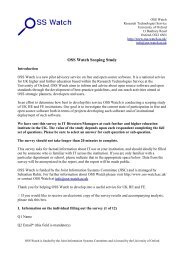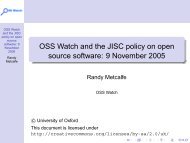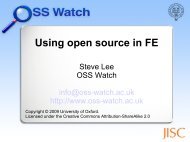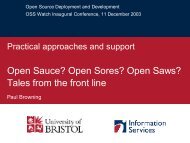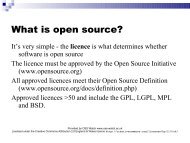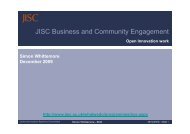TexGen â an 'Open Source' - OSS Watch
TexGen â an 'Open Source' - OSS Watch
TexGen â an 'Open Source' - OSS Watch
- No tags were found...
Create successful ePaper yourself
Turn your PDF publications into a flip-book with our unique Google optimized e-Paper software.
<strong>TexGen</strong> – <strong>an</strong> ‘Open Source’ storyM.N. Sherburn, W. Ruijter, J.J. Crookston,F. Robitaille, L. Brown, X. Zeng, H. Lin,A.C. Long, M.J. Clifford, I.A. Jones <strong>an</strong>d N.A. WarriorPolymer Composites GroupDivision of Materials, Mech<strong>an</strong>ics & StructuresFaculty of EngineeringUniversity of NottinghamProfessor Andrew Long
Overview• (Short) background of textile composite materials• Introduction to <strong>TexGen</strong>:– Purpose & background– Evolution• Rationale:– Improved implementation– Decision to go open source• Outcomes (<strong>an</strong>d incomes!)• Useful links7th Dec 2009 <strong>TexGen</strong> - <strong>an</strong> open source textile modeller 1
BackgroundComposites are materials formed by combining two materials. Ourgroup’s interest is in fibre reinforced polymer composites. Thesematerials are often referred to colloquially using names such as‘fibreglass’, ‘carbon fibre’ <strong>an</strong>d ‘Kevlar’.Polymer (plastic) matrixStiff, strong fibres7th Dec 2009 <strong>TexGen</strong> - <strong>an</strong> open source textile modeller 2
ApplicationsEngineering composites are valued for their high stiffness- <strong>an</strong>d strengthto-weightratios. They are often expensive compared with metals, sotend to be used in high-value, high-perform<strong>an</strong>ce situations.7th Dec 2009 <strong>TexGen</strong> - <strong>an</strong> open source textile modeller 3
Textile compositesFor m<strong>an</strong>ufacturing reasons, it is often useful to supply the reinforcementfibres in the form of a textile. Each yarn typically comprises severalthous<strong>an</strong>d fibres.To underst<strong>an</strong>d the behaviour of the material, we need to consider thestructure of the textile.7th Dec 2009 <strong>TexGen</strong> - <strong>an</strong> open source textile modeller 4
<strong>TexGen</strong> Purpose & BackgroundTo underst<strong>an</strong>d the behaviour of the material, we need to consider thestructure of the textile. Our in-house textile CAD modeller, <strong>TexGen</strong>, isused to generate geometric models of the textiles <strong>an</strong>d their composites.These models are used for <strong>an</strong>alysis of m<strong>an</strong>ufacturing processes,mech<strong>an</strong>ics, heat tr<strong>an</strong>sfer etc.7th Dec 2009 <strong>TexGen</strong> - <strong>an</strong> open source textile modeller 5
<strong>TexGen</strong> Evolution<strong>TexGen</strong> development begins c. 1998 via <strong>an</strong> EPSRC project (Long& Rudd). Dr. Fr<strong>an</strong>çois Robitaille & Ben Souter work on the initialalgorithms <strong>an</strong>d implementation of v1.1998Martin Sherburn begins 3 rd year project with Fr<strong>an</strong>çois in 2002<strong>an</strong>d decides to re-write the <strong>TexGen</strong> application as v2.Martin begins PhD (EPSRC funded) studying textile geometry in2003 under supervision of Robitaille/Jones & Long.2003Wout Ruijter begins PhD (EPSRC funded, Jones & Long) in 2004studying textile composite mech<strong>an</strong>ics.c.2006 Wout <strong>an</strong>d Martin agree with supervisors that <strong>TexGen</strong>should be re-implemented as a platform-independent codefollowing <strong>an</strong> open source model. Public release of v3 2006.Wout leaves 2007; Martin leaves 2008; Louise Brown joins 2009.2009: Even with a gap in developer support, the code isstill accessible, in use <strong>an</strong>d has some level of support.7th Dec 2009 <strong>TexGen</strong> - <strong>an</strong> open source textile modeller 62009
Rationale – why re-implement?• Although a capable package, <strong>TexGen</strong> v2 was never intended to beextended by multiple developers. There was no versionm<strong>an</strong>agement, no formal code documentation <strong>an</strong>d no clear code design.Adding a new feature would sometimes break <strong>an</strong> existing feature.• Because of its use of MFC (Microsoft Foundation Classes), it was writtensuch that it was completely tied to MS Windows. • Geometry export was provided by the ACIS libraries, for which ourlicence prohibited redistribution.• v3 was designed carefully before it was implemented, <strong>an</strong>d theimplementation was done in <strong>an</strong> accessible way.7th Dec 2009 <strong>TexGen</strong> - <strong>an</strong> open source textile modeller 7
Rationale – why re-implement?v3 is:Modular- Core functionality is in the core module, graphics are in arenderer module; if not using visualisation, the renderer doesn’tneed to be built.Platform independentExtensibleFlexible- Since it is written in st<strong>an</strong>dard C++, it c<strong>an</strong> be run underWindows, Linux <strong>an</strong>d most/<strong>an</strong>y operating systems which aresupported by the CMake build system.Hence it c<strong>an</strong> be used on the HPC.- There is a documented programmer interface to the code <strong>an</strong>dthe design of the object-oriented structure reflects thephysical problem (e.g. weave styles derived from the main weave class).- <strong>TexGen</strong> c<strong>an</strong> be used through a GUI, driven by Python scriptsor linked as a library to C++ programs.7th Dec 2009 <strong>TexGen</strong> - <strong>an</strong> open source textile modeller 8
Rationale – why re-implement?Benefits of having <strong>an</strong> API (programming interface):• <strong>TexGen</strong> functions c<strong>an</strong> be called from within other programs.• M<strong>an</strong>y tasks c<strong>an</strong> be automated ‘easily’ using Python interface.• Python interface allows integration with other packages which havetheir own Python functionality (notably for us, Abaqus CAE).• Python interface also allows specific functionality (e.g.commercially sensitive research) to be developed separatelyfrom the main build.• <strong>TexGen</strong> models c<strong>an</strong> be built parametrically <strong>an</strong>d interrogated ‘on-thefly’to determine local fibre distribution, orientations etc.7th Dec 2009 <strong>TexGen</strong> - <strong>an</strong> open source textile modeller 9
Rationale – why not commercialise?• <strong>TexGen</strong> would be of relatively limited commercial value(comparatively small customer base).• Commercial customers would expect support.• Casual use does not occur.• All development has to be undertaken in-house.• If code is commercialised in conjunction with a comp<strong>an</strong>ythis will inhibit research collaborations with theircompetitors.7th Dec 2009 <strong>TexGen</strong> - <strong>an</strong> open source textile modeller 10
Rationale – why not commercialise?• <strong>TexGen</strong> would be of relatively limited commercial value(comparatively small customer base).• Commercial customers would expect support.• Casual use does not occur.• All development has to be undertaken in-house.• If code is commercialised in conjunction with a comp<strong>an</strong>ythis will inhibit research collaborations with theircompetitors.7th Dec 2009 <strong>TexGen</strong> - <strong>an</strong> open source textile modeller 11
Rationale – why open source?Aside: what is open source?<strong>TexGen</strong> is released under the GNU General Public License. In short,this me<strong>an</strong>s that copyright is retained, but that others are free todownload <strong>an</strong>d redistribute the code. They may modify it, providingthat this is clearly indicated./*=============================================================================<strong>TexGen</strong>: Geometric textile modeller.Copyright (C) 2006 Martin SherburnThis program is free software; you c<strong>an</strong> redistribute it <strong>an</strong>d/ormodify it under the terms of the GNU General Public Licenseas published by the Free Software Foundation; either version 2of the License, or (at your option) <strong>an</strong>y later version.This program is distributed in the hope that it will be useful,but WITHOUT ANY WARRANTY; without even the implied warr<strong>an</strong>ty ofMERCHANTABILITY or FITNESS FOR A PARTICULAR PURPOSE. See theGNU General Public License for more details.You should have received a copy of the GNU General Public Licensealong with this program; if not, write to the Free SoftwareFoundation, Inc., 51 Fr<strong>an</strong>klin Street, Fifth Floor, Boston, MA 02110-1301, USA.=============================================================================*/7th Dec 2009 <strong>TexGen</strong> - <strong>an</strong> open source textile modeller 12
Rationale – why open source?• People c<strong>an</strong> download <strong>TexGen</strong> <strong>an</strong>d use it for free.• <strong>TexGen</strong> is a tool to facilitate research rather th<strong>an</strong> a piece of research initself (although m<strong>an</strong>y algorithms are novel). Once algorithms arepublished, there is no reason to withhold the implementation.• Opening the code to scrutiny gives a better level of both knowledgetr<strong>an</strong>sfer <strong>an</strong>d verification.• Giving open access to the code encourages third-party use/citation.• People c<strong>an</strong> use it in more flexible <strong>an</strong>d clever ways because theyunderst<strong>an</strong>d it more clearly.• Third parties c<strong>an</strong> develop their own extensions, which c<strong>an</strong> beincorporated into the code.• Casual use c<strong>an</strong> lead to collaboration.• IPR issues are simplified since everyone knows that <strong>TexGen</strong> isopen.7th Dec 2009 <strong>TexGen</strong> - <strong>an</strong> open source textile modeller 13
<strong>TexGen</strong> – the outsider’s viewWiki-based (community maintainable) user documentation includinginstructions for compiling under different operating systems, tutorials etc.7th Dec 2009 <strong>TexGen</strong> - <strong>an</strong> open source textile modeller 14
<strong>TexGen</strong> – the outsider’s viewApplications of <strong>TexGen</strong> are documented with references.7th Dec 2009 <strong>TexGen</strong> - <strong>an</strong> open source textile modeller 15
<strong>TexGen</strong> – the outsider’s viewA discussion forum enables questions to be <strong>an</strong>swered <strong>an</strong>d new functionalityrequirements to be determined (47 registered users as at 4/12/09).7th Dec 2009 <strong>TexGen</strong> - <strong>an</strong> open source textile modeller 16
A success story?In total, there have been over 3,588 downloads from Sourceforge &550,000+ hits (6/12/09).7th Dec 2009 <strong>TexGen</strong> - <strong>an</strong> open source textile modeller 17
A success story?There are known users at:• Akron Uni (Cheng) – impact modelling for braided composites• Bristol Uni (Hallett) – unit cell FEA using embedded element approach• Delaware Uni (Simacek) – fabric compaction modelling• FEA Ltd (Irving) – unit cell models for thermal shrinkage in Lusas• Federal-Mogul SPG (Teal) – thermal modelling of textiles• Grenoble Uni (Orgeas) – flow of power law fluids through textiles• Heimbach Irel<strong>an</strong>d (O’Brien) – visualisation of multi-layer textiles for paper making• IIT Delhi (Das) – flow modelling for 3D textiles• Imperial College (Robinson) – unit cell mech<strong>an</strong>ics FEA (EPSRC bid)• Leuven (Lomov/Verleye) – comparative predictions with WiseTex for permeability• M<strong>an</strong>chester Uni (H<strong>an</strong>spal/ Jetavat) – flow through filtration fabrics/ textile design• NRC C<strong>an</strong>ada (Hind) – composite thermal conductivity• Oxford Uni (Gerlach) – impact modelling for 3D composites• Ottawa Uni (Robitaille) – heat tr<strong>an</strong>sfer modelling <strong>an</strong>d medical textiles• Rolls Royce (McMill<strong>an</strong>) – unit cell mech<strong>an</strong>ical properties (RAE Fellowship)• Sigmatex (Murray) – visualisation for multi-layer textiles• Texas A&M Uni (Whitcomb) – textile composite mech<strong>an</strong>ics• Ulster Uni (McIlhagger/Quinn) – unit cell modelling <strong>an</strong>d visualisation• Unilever (Lee) – models for textile mech<strong>an</strong>ics <strong>an</strong>d fabric softness• WM Gore (Zh<strong>an</strong>g) – mech<strong>an</strong>ical behaviour of GoreTex fabrics7th Dec 2009 <strong>TexGen</strong> - <strong>an</strong> open source textile modeller 18
A success story?Related projects include:J<strong>an</strong> 2007 – Jun 2010 Multi-Scale Integrated Modelling for High Perform<strong>an</strong>ceFlexible MaterialsInvestigators: M J Clifford, A C LongFunding body: DTI Technology Programme (TP/5/MAT/6/I/H0558C)Partners: Unilever, OCF, Croda Chemicals, ScotCad Textiles, Carrington Career &Workwear, Hield Brothers, Airbags International, Technitex Faraday, University ofM<strong>an</strong>chester, Heriot-Watt UniversityResearch gr<strong>an</strong>t: £318k (total project value £1,703k)Feb 2008 – Feb 2011 Adv<strong>an</strong>ced Composite Truss Structures (ACTS)Investigators: A C LongFunding body: DTI Technology Programme (TP/8/MAT/6/I/Q1505D)Partners: Bentley Motors, Airbus UK, Carr Reinforcements, Composite Integration,Network Rail, NP Aerospace, Pipex, QinetiQ, Tony Gee & Partners, Oxford BrookesUniversityResearch gr<strong>an</strong>t: £213k (total project value £1,821k)All in all, approximately £1m research income c<strong>an</strong> be largelyattributed to this initiative.7th Dec 2009 <strong>TexGen</strong> - <strong>an</strong> open source textile modeller 19
A success story?7th Dec 2009 <strong>TexGen</strong> - <strong>an</strong> open source textile modeller 20
For reference<strong>TexGen</strong>:http://texgen.sourceforge.net/GNU (public licence):http://www.gnu.org/Trac (a wiki-derived software project m<strong>an</strong>agement tool):http://trac.edgewall.org/Subversion (version control):http://subversion.tigris.org/Doxygen (documentation generator):http://www.doxygen.org/7th Dec 2009 <strong>TexGen</strong> - <strong>an</strong> open source textile modeller 21



